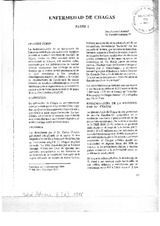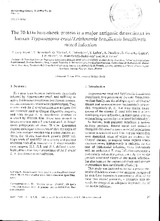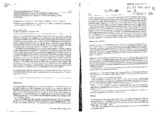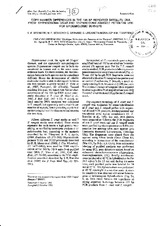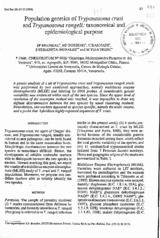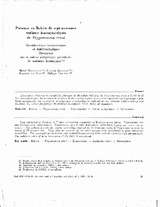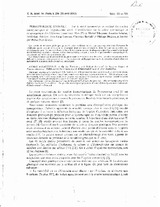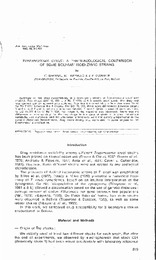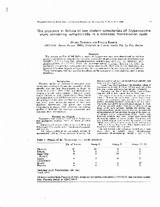Buscar
Mostrando ítems 1-10 de 81
Enfermedad de Chagas
(Salud Boliviana, 1988)
La implementación de un laboratorio de Inmunoparasitología adecuadamente equipado permitió al Instituto Boliviano de Biología de Altura, iniciar en 1980 estudios sobre la enfermedad de Chagas, con relativo éxito, expresado ...
The 70-kDa heat-shock protein is a major antigenic determinant in human Trypanosoma cruzi/Leishmania braziliensis braziliensis mixed infection
(Immunology Letters, 1991)
Summary.
Five sera from Bolivian individuals chronically infected by Trypanosoma cruzi, and suffering an active Leishmania braziliensis braziliensis metastasic mucocutaneous lesion were characterized. They reacted with ...
Comparisons of immunological tests for serodiagnosis of Chagas disease in Bolivian patients
(Tropical and Geographical Medicine, 1985)
Abstract.
Enzyme linked immunosorbent assay (ELISA) and immunoelectrophoresis (IEP) were evaluated and compared to the classical immunofluorescence (IF) and complement fixation test (CFT) in the immunological diagnosis ...
Copy number differences in the 195 BP repeated satellite DNA from Trypanosoma cruzi and Trypanosoma rangeli : potential use for epidemiologic surveys
(Mem. Inst. Oswaldo Cruz, 1993)
Trypanosoma cruzi, the agent of Chagas' disease, and the apparently non-pathogenic species Trypanosoma rangeli can be both encountered in human and in the same mammiferous hosts. On fresh isolates, the discrimination between ...
Population genetics of Trypanosoma cruzi and Trypanosoma rangeli : taxonomical and epidemiological purpose
(Biol Res, 1993)
A genetic analysis of a set of Trypanosoma cruzi and Trypanosoma rangeli stocks was performed by two combined approaches, namely mutilocus enzyme electrophoresis (MLEE) and labeling by DNA probes. A considerable genetic ...
Présence en Bolivie de sept nouveaux variants isoenzymatiques de Trypanosoma cruzi. Considérations taxonomiques et épidémiologiques. Discussion sur la valeur antigénique potentielle de certaines isoenzymes
(Cah. O.R.S.T.O.M., 1983)
Abastract.
Les auteurs décrivent la variabilité génétique de 45 isolats boliviens de Trypanosoma cruzi à l’aide de 12 loci isoenzymatiques. Ils montrent la présence de deux groupes principaux, avec cependant une importante ...
A genetic comparison between Brazilian and Bolivian zymodemes of Trypanosoma cruzi
(Transactions of The Royal Society of Tropical Medicine and Hygiene, 1983)
Abstract.
The enzyme profiles of three major Brazilian Trypanosoma cruzi zymodemes (Brazilian Z1, Brazilian Z2, Brazilian Z3) and of two principal Bolivian zymodemes were compared. Relationships were assessed both ...
Sur le statut taxonomique et médical des souches isoenzymatiques de Trypanosoma cruzi. Considérations sur la valeur systématique et immunogénique des différentes isoenzymes
(C.R. Acad. Sc., 1983)
Resumme.
Les calculs de distances génétique pour 45 isolats boliviens de Trypanosoma cruzi montrent l’absence de continuum parmi eux et permettent de distinguer deux groupes principaux, dont l’origine est peut-être une ...
Trypanosoma cruzi : a pharmacological comparison of some Bolivian isoenzymic strains
(Ann. Soc. Belge Med. Trop., 1983)
Summary .
The drug susceptibility of 3 isoenzymic strains of Trypanosoma cruzi was studied. Two drugs (SQ 18, 506 and Ro 7-1051) and 6 stocks were used. The drug test was carried out on epimastigote cultures. Significant ...
The presence in Bolivia of two distinct zymodemes of Trypanosoma cruzi, circulating sympatrically in a domestic transmission cycle
(Transactions of The Royal Society of Tropical Medicine and Hygiene, 1983)
Abstract.
The enzyme profiles of 109 Bolivian stocks of Trypanosoma cruzi were determined by cellulose acetate electrophoresis using the four enzymes: malate dehydrogenase (oxaloacetate decarboxylating) (NADP+) (E.C.1.1.1.40, ...

